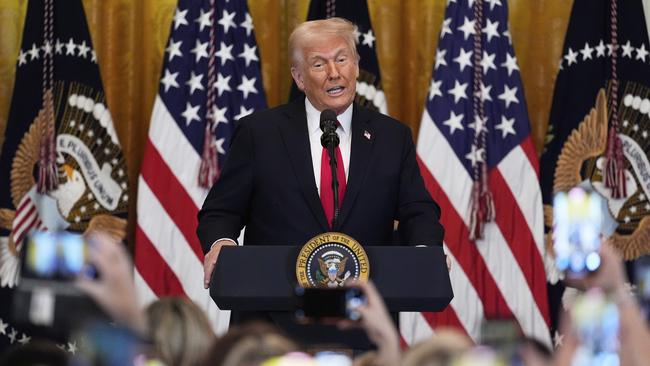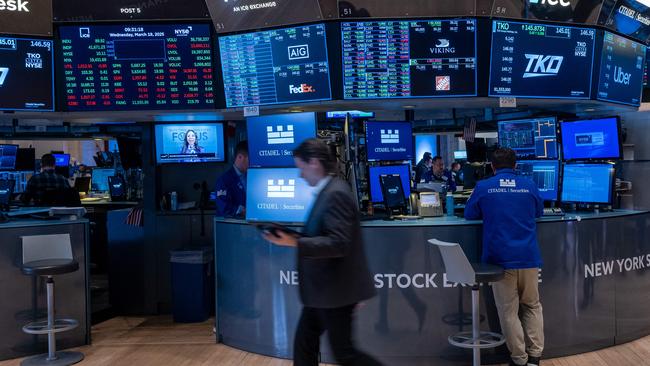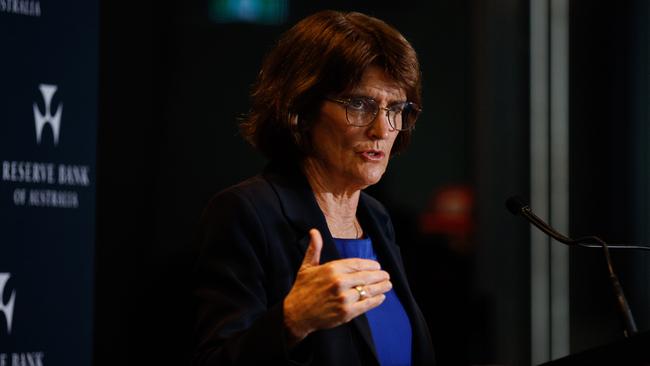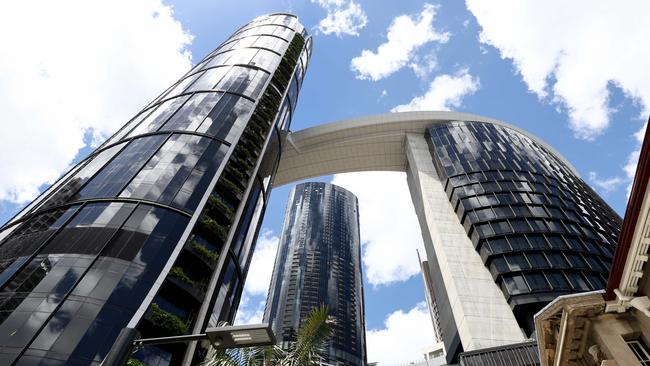Where’s my RBA rate cut? Blame Trump’s tariffs
Australia’s central bank is trying to war game how tariffs will impact inflation and global growth. The real answer is it doesn’t know.

Business
Don't miss out on the headlines from Business. Followed categories will be added to My News.
There’s a new and highly unpredictable force that central banks are grappling with when it comes to setting interest rates: Donald Trump.
Trump’s trade war is threatening to upending what would have been a smooth pathway for the Reserve Bank cutting the cash rate over the coming year and in doing so giving borrowers relief.
The threat of trade escalation already cruelled chances of an April rate cut, with rates on Tuesday kept steady at 4.1 per cent, and could change the calculus of a widely expected May rate cut.
The US President’s so-called ‘Liberation Day’ – taking place early Thursday Australian time – where Trump outlines a swathe of reciprocal tariffs could mark the beginning of a new and more intense phase of the global trade war. Then it’s a matter of how the world choses to respond.
The damage to the global economy would be severe if Trump issues tariffs above what is expected to be a baseline 25 per cent rate. The first round of tariffs on Canada, China and steel outlined in recent weeks are yet to have an obvious impact on trade, however this war has barely started.
The risk is all may not be known on April 2 in Washington, with whatever Trump announcing likely to be his opening gambit for trade negotiations. Therefore it would smarter to see Liberation Day as a starting point rather than the end game for tariffs.
Still, its the looming threat of tariffs that has sent global markets in a tailspin. Wall Street just posted its worst quarter in three years, with the broad S&P 500 dropping 4.6 per cent. Australia’s stock benchmark, the S&P/ASX 200 fell 3.9 per cent, also the worst performance since the June quarter of 2022.
The RBA is trying to war game how Trump’s tariffs will impact the economy both globally and here, especially inflation. And the real answer is it doesn’t know. It’s been talking to other central banks across similar economies around the world about this and has mapped out several possibilities.
“We’re not on our own in navigating this unpredictability,” RBA governor Michele Bullock said.
In the eyes of the central bank, with its newly-expanded interest rate setting board, the Australian economy is turning over, so it’s better to sit tight and wait until it has better information about where global trade is headed.
Going into the April meeting, there was a one-in-three chance of an April interest rate cut. Without Trump’s tariff threat, this would have been closer to a 50-50 chance.
And while a cut on Tuesday would have ignited a tightly-contested federal election, the RBA hasn’t shied away from cutting in the midst of an election campaign when it needed too. Bullock said the election didn’t factor into her thinking, and it wasn’t mentioned by her rate setting board. Beside, stretched households are just looking for a break and have little interest dancing around the political cycle.
Bullock kicking kicked off the central bank’s easing cycle in February with a cautious 25-basis-point cut in February.
Going into this week’s meeting, the market had been fully pricing the RBA to issue an interest rate cut come the May 20 meeting. This puts the bank’s next move well after the federal poll.
The market also has another rate cut pencilled in by the August meeting.
But it’s this uncertainty about the global outlook which is “significant,” Bullock said on Tuesday. In the RBA’s prepared statement, the rhetoric around the impact of trade disruption had increased.

Trump’s tariffs “are having an impact on confidence globally and this would likely be amplified if the scope of tariffs widens, or other countries take retaliatory measures”.
“What happens in this Trump tariff trade war depends very much on a number of things. It depends on how other countries respond. Do they respond with similar sorts of tariffs themselves?”
All things being equal, rising tariffs in the US would be good for cutting inflation elsewhere because it slows the global economy (especially the US economy) and excess supply of goods and commodities are looking for a home.
However, as far as the RBA is concerned there’s a real risk, inflation could go the other way. There’s no telling how disruption could hit a globally-interconnected supply chain or simply make the cost of producing goods more expensive. Just like the onset of the Ukraine-Russia war this could see prices across key goods rise again and inflation eventually return to Australia.

For Australia the big X-factor in all of this is how China responds to Trump.
Not only with its own set of tariffs but also on whether it issues a massive stimulus to protect its own economy. There is also risk if China slows there could be an impact in terms of growth here.
China, is “our most important trading partner,” Bullock said.
Several key central banks have started cutting rates since the start of the year, including the UK, Canada and the US Federal Reserve. But they’re now are starting to become more sensitive to the interest rate risks. The US Fed is becoming increasingly cautious around inflation given the policy uncertainty.
However, in the surest sign the RBA is laying the groundwork for another cut it retained a policy easing bias. It said on Tuesday it believes monetary policy remains restrictive, noting there was a further decline in underlying inflation. It also pointed to risks that the recovery in household consumption could be slower-than-expected a factor further dampening growth.
But to cut now? There’s just too much Trump upsetting the equation.
Casino loan chase
Star Entertainment could issue an update as early as Wednesday around the status of its all-or-nothing $940m loan it was negotiating with a consortium led by Melbourne property scions Salter Brothers.
It’s been over three weeks of negotiations between Star and Salters on the terms of the critical debt refinancing plan designed to pay out existing lenders and help the casino trade through its cash crunch.
Salters has been undertaking exclusive due diligence to offer a commitment and pricing of the five-year loan. This was initially expected to be finalised by March 18, before an extension was granted to close of business April 1.
The Star board would have to considering the Salter’s lending proposal and update investors on the next step.

The debt refinancing was the key part of Star’s three-strep survival plan that involving a pivot to the Gold Coast and locking in short term financing. At the start of March. Star had been just days away from collapse, with cash quickly running out. Part of that deal involved securing a short term $250m loan from US financier King Street Capital Management, a facility which is available until the end of this month. The Salters loan was designed to pay down the $250m bridging loan.
At the same time, Star’s Hong Kong partners led by Chow Tai Fook Enterprises agreed to inject up to $45m cash into the casino operator over March. Those funds are for a property swap that sees the Hong Kong partners emerge with the new Queens Wharf casino in Brisbane in exchange for their interests in the Gold Coast.
While much relies on securing the Salters loan, there’s been some last minute hitches with Star selling its Sydney Events Centre to Stephen Found’s Foundation Theatres for $60m. That deal was set to close on March 10, but talks have been ongoing since then. An update on the sale could come as early as this week. Investors too are waiting for Star’s December half accounts, which are now a month overdue.
eric.johnston@news.com.au
More Coverage
Originally published as Where’s my RBA rate cut? Blame Trump’s tariffs




